
Friday, 2 February 2018, 6:00pm-9:00pm
Douglas County Fair Grounds, Dreher Building, 2110 Harper St., Lawrence KS 66046
The Sustainability Action 2018 Annual Meeting will host a panel discussion on “Protecting Water in Kansas: Quality and Availability”, with a local, regional, and state focus. The panel will consist of water activists who are leaders in their own organizations, and who draw upon varying perspectives for protecting our valuable waters. Our intent is to educate, inspire, bring additional people into the movement, collaborate, and mobilize to action. The following representatives from these groups will be the panelists:
Dawn Buehler – Friends of the Kaw: Kansas Riverkeeper
Elaine Giessel – Kansas Sierra Club
Thad Holcombe – Water Advocacy Team
Rachel Jefferson – Historic Northeast Midtown Association
Karin Pagel-Meiners – Wakarusa Group – Kansas Sierra Club
Jessica Skyfield – Kansas Water
Eric Kirkendall, moderator – Sustainability Action Network
Water is our most precious good, enabling and cleansing all life. Only 2.5% of Earth’s water is fresh – present in lakes, streams, aquifers, and the atmosphere. It is an all-encompassing concern, spanning the aspects of water quality, quantity, privatization, sea level rise, wars, and more. Water availability is threatened by drought, desertification, pollution, urbanization, overconsumption, and privatization. Water quality is threatened by our industrial society in several ways, from injection wells and fracking, to nitrate fertilizer and pesticide runoff, and pharmaceuticals and other toxins.

Most of the pollution and overconsumption can be traced to industrial activities such as fossil fuel extraction, petrochemical plants, power generation, urban lawn chemicals, and industrial agriculture. The cumulative result of all this is that our streams have become open sewers, aquatic ecosystems are compromised, aquifers are contaminated or threatened, crop failures are more common for both irrigating and subsistence farmers, cost of water treatment is rising, algae blooms trigger ocean dead zones, and there is a drinking water crisis in numerous cities nationwide.

The evening will begin with a pot luck dinner at 6:00pm sharp (arrive a little early with your dish). At 7:00pm the kitchen will close, and we will welcome everyone and give an overview of water issues concerning our local communities. Then after introductions, each of the panelists will describe the state of water as they see it, and how their organization is working to protect our waters for the common good. In the second hour, we want to explore how all of us can best work together as a team to define and spark action that will lead to substantive change. Each of the panelists and their organizations have distinctive approaches to these issues, and any potential actions will be more effective if we combine our efforts. We hope you will join us.
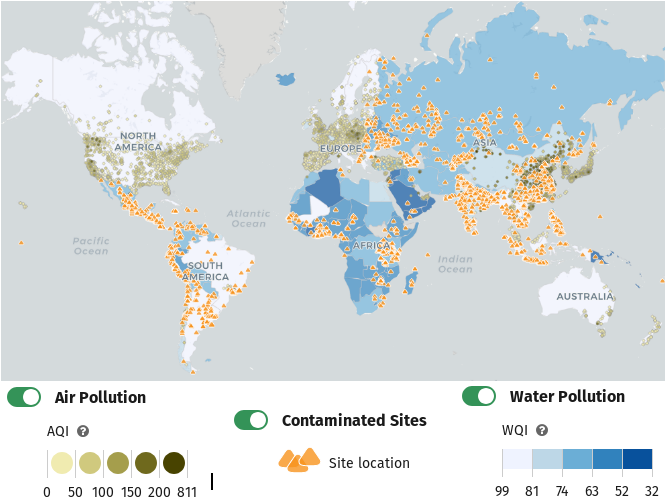
More than war and violence – more than smoking, hunger, or natural disasters – more than AIDS, tuberculosis, and malaria combined. More people are prematurely killed worldwide each year from polluted air and water, at least 9 million, than the total number of people who die every year from these other major killers. This data comes from an extensive study by the Lancet Commission on Pollution and Health that was released on 19 October 2017. The study found that one in six premature deaths, or 17 percent of the world population, are attributable to toxic exposure to environmental pollutants, and that the financial cost is about US$4.6 trillion, or about 6.2 percent of the global economy.
Lead author of the report, and Dean of global health at the Icahn School of Medicine at Mount Sinai, New York, Philip Landrigan, said “Pollution is a massive problem that people aren’t seeing because they’re looking at scattered bits of it”. The figure of 9 million pollution-related deaths is considered a low estimate by Commission researchers, who are projecting that the impacts will be better quantified with new assessment methods and new research.
As one might expect, “The vast majority of pollution-related deaths — 92 percent — occur in low- or middle-income countries, where policy makers are chiefly concerned with developing their economies”, according to the report. The continents of Asia and Africa have the worst incidence of toxin-induced premature deaths, and India tops the list with one out of every four premature deaths, or some 2.5 million, caused by pollution. And in the wealthier countries that have curbed much of the early occurrences of industrial pollution, it’s the lower class poor communities that still suffer from negligent corporate emissions and lax enforcement – the so-called environmental justice communities. As the article states, “According to the NAACP’s research, the percentage of African Americans in the fenceline zones near chemical plants is 75 percent greater than for the country overall; for Latinos, 60 percent”. Learn more at – Pollution Kills an Estimated 9 Million People Every Year.
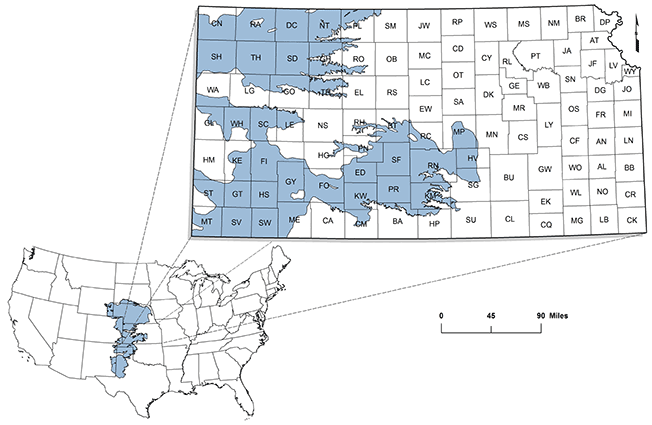
The Ogallala Aquifer (technically the High Plains Aquifer) underlies an area in eight states, of approximately 174,000 sq mi, being one of the world’s largest aquifers. 30,800 square miles of that is in western and central Kansas, 900 sq mi in Colorado, 20,600 sq mi in Texas, and it is under virtually all of the state of Nebraska. The aquifer stores as much water volume as Lake Huron (2.9 billion acre-feet). It provides 30 percent of the United States’ irrigation, contributing to an astounding 20 percent of the country’s entire agricultural output. The Ogallala water accumulated slowly over tens of thousands of years, and aquifer recharge occurs very slowly because of scant rainfall on the high plains. In most of the aquifer, except for Nebraska, the irrigation use by high water-demand crops like corn is far greater than the recharge rate. In Colorado alone, farmers pumped water out of 4,000 wells, sucking out as much as 500 gallons per minute per well.
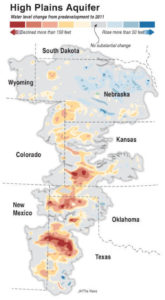
In western Kansas, farmers are drawing down their region’s groundwater at more than six times the natural rate of recharge. Kansas State University researchers found that 30 percent of the region’s groundwater has been tapped out. As underground water levels drop, pumping from a greater depth becomes more and more expensive, to the point of unprofitability. The advent of center-pivot irrigation systems in the 1960’s allowed people to irrigate uneven terrain, which opened up large new areas for water thirsty crops like corn. That led, in turn, to large feedlots and packing plants. The combination of corn for cattle feed, and corn for government subsidized ethanol production has driven a tripling of the price of corn since 2002, and Kansas farmers have responded by increasing the acreage of irrigated cornfields by nearly a fifth. This price bubble will burst when the Ogalla Aquifer drops so deep that pumping costs will become prohibitive. By then, the midwest will have become the Great American Desert. Learn more at – The real reason Kansas is running out of water, and Why These 8 States Could Soon Form the ‘Great American Desert’.

There are two kinds of wells used for fossil fuels: extraction wells to draw either petroleum or natural gas from geological formations, and injection wells to force liquids under high pressure deep down underground. Injection wells can be of three types. The first is to force saltwater mixed with CO2 into oil bearing shale to thin the oil so it will flow freely up an extraction well. The second is to force the saltwater that returns with oil to the surface back down into deep rock layers to dispose of it. And the third is to force fracking wastewater that returns with oil to the surface back down into deep rock layers to dispose of it.
Here are three concerns about injection wells associated with petroleum and gas drilling. The most common one is the high potential for triggering earthquakes in unstable geologic formations. The Kansas Geological Survey links earthquakes to wastewater disposal, and has increased restrictions as a result of the 2016 earthquakes in southern Kansas. A second concern is the potential for the deep-injected wastewater to migrate into freshwater aquifers. And the third concern is the potential for the brine wastewater to cause land subsidence and sink holes near the oil fields – Brine Disposal, Land Subsidence, Salt Dissolution: Oil and Gas Operations.
As far as we know, there is no fracking in Douglas County, all seemingly concentrated in the southern-most Kansas counties bordering Oklahoma. But there is petroleum in Douglas County in relatively small fields, and dozens, if not hundreds, of wells are scattered around the eastern part of the county. Most of these wells produce little, so operators are resorting to what is called “enhanced recovery” technology, or “tertiary recovery”. This amounts to applying pressure to the pockets of petroleum by injecting high pressure saltwater into the rock that dilutes the petroleum and forces it to the surface. A rash of these saltwater injection wells have come to the attention of the public recently, because operators must get permits from the Kansas Corporation Commission (KCC).
 In mid-October 2017, a contractor named Midstates Energy Operators filed applications with the KCC for saltwater injection wells on two properties southeast of Lawrence. There had been earlier applications, and permits granted in the general vicinity, as well as dozens south and east of there near Baldwin City, but only a few people knew of them. The KCC permit process is very opaque for the public in many ways, one such being that a “public” notice for an application need be published for only one day, and appears in the classified ad supplement, not the main newspaper. It so happened that a Sierra Club member noticed the two recent applications, and alerted others.
In mid-October 2017, a contractor named Midstates Energy Operators filed applications with the KCC for saltwater injection wells on two properties southeast of Lawrence. There had been earlier applications, and permits granted in the general vicinity, as well as dozens south and east of there near Baldwin City, but only a few people knew of them. The KCC permit process is very opaque for the public in many ways, one such being that a “public” notice for an application need be published for only one day, and appears in the classified ad supplement, not the main newspaper. It so happened that a Sierra Club member noticed the two recent applications, and alerted others.
The Midstates Energy Operators injection well applications are for two adjacent properties southeast of Lawrence and southwest of Eudora, three miles south of the K-10/Dg. Co. 1057 Rd. interchange.
-
One is the Thrasher Lease on the Mr. Pat Thrasher property, N.E. of the intersection of Dg. Co. 1057 Rd. and 458 Rd. The permit application is to “amend the injection well permit #E-31,965, Thrasher #10, Thrasher I-5, on Sec. 25, Twp. 13S, R 20E, Douglas County, Kansas”. Protest letters must reference that exact description. The KCC has issued to this case a main reference Docket Number of 18-CONS-3195-CUIC, and it can be viewed at Thrasher Docket Details.
-
The other is the Hadl Lease on the Mr. Vernon Hadl property, S.E. of the intersection of Dg. Co. 1057 Rd. and 458 Rd. The permit application is for “enhanced recovery of injection wells under permit #E-32,566, Hadl I-1 and Hadl I-2, on Sec. 36, Twp. 13S, R 20E, Douglas County, Kansas” Protest letters must reference that exact description. The KCC has issued to this case a main reference Docket Number of 18-CONS-3196-CUIC, and it can be viewed at Hadl Docket Details.
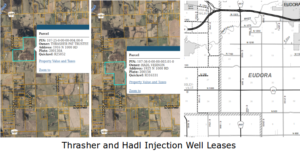
The public is encouraged to send protest letters (if so inclined) before the deadline of 27 November. The KCC ordered the applicant to republish the public notices with a correct protest window of 30 days. The technical deadline is Saturday, 25 November, but since the KCC is closed on weekends, the effective deadline is extended to Monday, 27 November. To be valid, protest letters must ARRIVE AT THE KCC OFFICES on or before the deadline (not the postmark date). The U.S. Postal Service won’t deliver on Thanksgiving, and the KCC will be closed from Thursday through Sunday. That means that letters must arrive at the KCC either by Wednesday, 22 November, or Monday, 27 November. Play it safe and aim for the 22nd.
 However – there now is an electronic way to file a protest letter. No postage, no delay, no uncertainty, and it works any day, holiday or not, including Saturday 25 November. Go to the KCC website E-filing link at – https://puc.kcc.ks.gov/e-filing/e-express/, where you can upload a PDF version of your protest letter (not a Word.doc version). Reference each application with the Docket Number, and put the Docket Number in your letter also. To get site access, you first must create a user name and a password, just like you might for Craig’s List or your kid’s school grades. E-filing is faster, no envelopes and stamps, and you get a notification back that your letter was received.
However – there now is an electronic way to file a protest letter. No postage, no delay, no uncertainty, and it works any day, holiday or not, including Saturday 25 November. Go to the KCC website E-filing link at – https://puc.kcc.ks.gov/e-filing/e-express/, where you can upload a PDF version of your protest letter (not a Word.doc version). Reference each application with the Docket Number, and put the Docket Number in your letter also. To get site access, you first must create a user name and a password, just like you might for Craig’s List or your kid’s school grades. E-filing is faster, no envelopes and stamps, and you get a notification back that your letter was received.
If using the U.S. Postal Service (or other delivery services), mail it to: Kansas Corporation Commission, Attn: Rene Stucky, Conservation Division (Oil & Gas), 266 N. Main St. Ste. 220, Wichita, KS 67202-1513. It’s best to mail letters Certified/Return Receipt, to get proof that a letter was delivered.
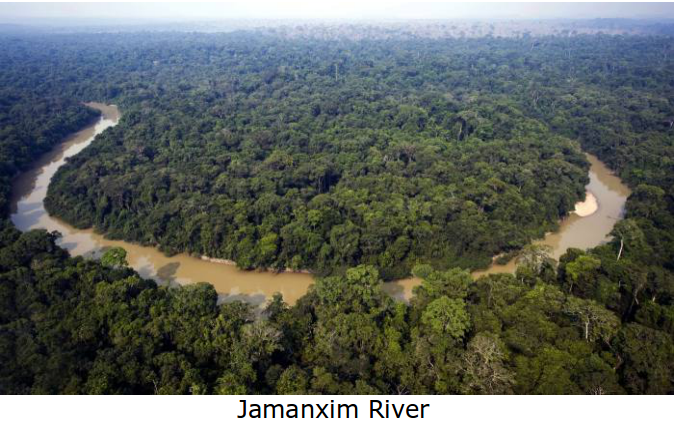
It may come to light that Trump gained occupancy of the White House fraudulently, and has presumed the power to wreak havoc on our environmental protections. But consider the parallel case in Brazil, different only in that the actors are more amateurish.
Michel Temur was installed as Interim President after his centrist Democratic Movement Party (PMDB) led the impeachment of President Dilma Ruosseff of the leftist Workers’ Party (PT). Temur and Senator Aécio Neves, who was Rousseff’s 2014 opponent in the presidential campaign, had accused Rousseff of taking illegal state loans to shore up a tanking economy. Though no proof was produced against Rousseff, she was impeached anyway. Now however, there has emerged hard evidence of criminality by both Temur and Neves. Neves was caught on tape requesting 2 million Reals from a businessman, and was removed from office by a Supreme Court ruling. Temer was caught on tape also, when endorsing ongoing bribes to maintain the silence of former House Speaker Eduardo Cunha, who presided over Dilma’s impeachment – After Latest Bombshells, Only Michel Temer’s Removal and New Elections Can Save Brazil’s Democracy.

Temur is Brazil’s most unpopular leader on record. While he is momentarily refusing to resign, his removal seems inevitable, as his key allies are starting to abandon him. But just like in the U.S. where a *president who some consider a moron is eliminating environmental “impediments” to corporate profits, in Brazil a president considered a felon is doing the same. Even when these two are gone, their damage will have been done. Most of Temur’s damage in Brazil is the decimation of the Amazon rainforest and its ability to sequester vast amounts of CO2, making the planet less livable for all of us. Globally, an estimated 7.8 BMtC (billion tons of carbon per year) come from fossil fuels and cement manufacturing, and 1.1 billion tons of carbon come from deforestation for agriculture. Forests and other plant communities currently sequester an estimated 2.6 BMtC, or 29% of total global emissions – The Great American Stand Report.pdf (page 10).
The Brazilian agricultural lobby was a key player in replacing Rousseff with Temur, so Temur is obliging their desires. With soybeans and beef cattle a large part of the Brazilian economy, agribusinesses and large landholders have been pushing through legislation to reverse longstanding protections for the rainforest. Temer is also fast-tracking major development projects that will lead to further deforestation, including hydroelectric dams and highways. On top of which, a 43% cut in the Ministry of Environment budget and 44% cut in science research budgets will reduce environmental law enforcement in Amazonia to virtually zero – Amazon rainforest under threat as Brazil tears up protections. More directly, Temur has proposed legislation to reduce the size of the Jamanxim National Forest by about 862,610 acres, or 27% (an area roughly the size of Portugal). He also has has abolished a vast national reserve of roughly 17,800 square miles (bigger than the size of Denmark) to open the area to commercial mining of gold, iron, and manganese – Brazil scraps Amazon reserve to allow mining.

Soybeans and cattle grazing form the backbone of Brazil’s agriculture sector, which is 5% of GDP, but a full 29% when processing and marketing is added in. The record soy harvest this year, plus a strong comeback in the corn harvest, has been credited with pulling the Brazilian economy out of a multi-year recession – Agriculture, a strategic sector for Brazil’s economic growth. Out of economic priorities, many concessions are being made to soy and meat producing interests, a major one being the opening of more land through deforestation. But due to opposition by conservationists, agribusiness giants like Cargill and Archer-Daniels Midland pledged not to deforests the Amazon, agreeing to an Amazon Soy Moratorium in 2006. However, large-scale soy growers simply moved their plantations to areas like the Cerrado Biome, a tropical savanna next to the Amazon Biome, with an enormous capacity for storing CO2 – Amazon deforestation linked to Cargill, McDonald’s and British retail giants. In an all too common scenario, the rainforest is at the mercy of the Brazilian and global economies.
On 23 October 2017, 92 of the world’s largest banks will meet in São Paulo, Brazil to recommit to the Equator Principles, a set of rules guiding which industries and projects they will and won’t finance. These so called “Equator Banks” have promised to avoid or minimize the social, environmental and climate impacts of such projects. But the currently worded principles are too vague to prevent banks from financing dirty oil, deforestation, coal, and mega-hydro dams. So a coalition of 65 environmental, human rights and Indigenous Peoples’ organizations are organizing a global action on 23-24-25 October. They are calling on the Equator Banks to completely revise the outdated Equator Principles to include an explicit commitment to the Paris climate goal of limiting global temperature rise to well below 2 degrees, and to include Indigenous People’s rights to Free Prior and Informed Consent (FPIC) before investment in projects on their lands. Learn more here – Equator Banks Called Upon to Act on Climate Change and Indigenous Peoples’ Rights. And you may then want to sign a petition to the Equator Banks here – Equator Banks, Stop Financing Climate Disasters and Respect Indigenous Rights.






 In mid-October 2017, a contractor named
In mid-October 2017, a contractor named 
 However –
However – 


Recent Comments